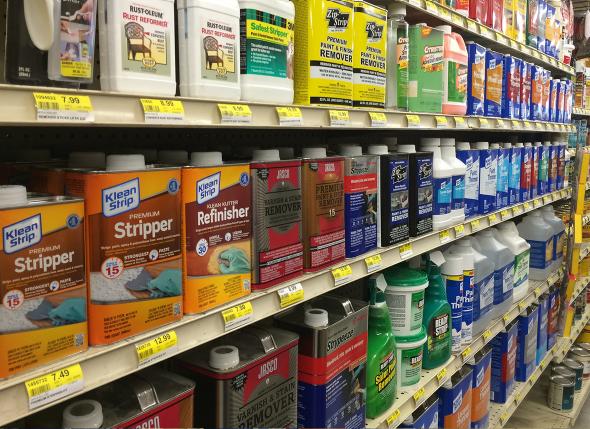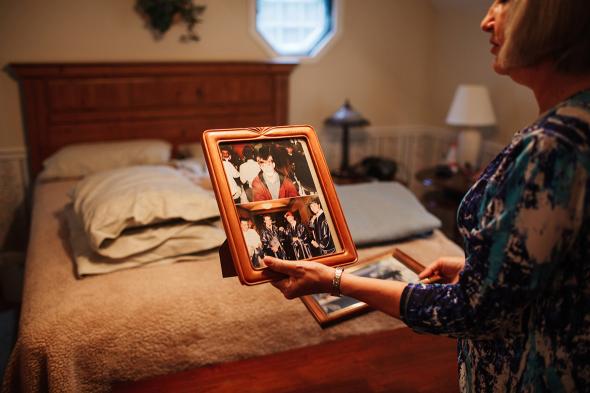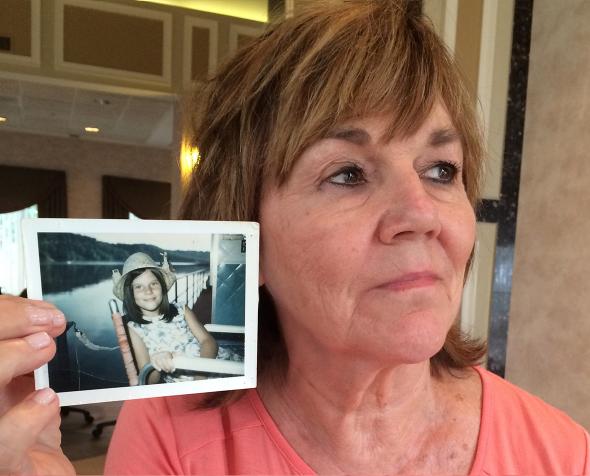Breathing Death
This chemical is found in most hardware stores and kills suddenly. Why has the EPA done nothing?

Photo by Jamie Smith Hopkins/Center for Public Integrity
Johnathan Welch was 18 and working through lunch when the fumes killed him, stealing oxygen from his brain, stopping his heart.
The chemical linked to his death in 1999 wasn’t a newly discovered hazard, nor was it hard to acquire. Methylene chloride, which triggered similar deaths dating as far back as the 1940s, could be bought barely diluted in products on retail shelves. It still can. And it’s still killing people.
The solvent is common in paint strippers, widely available products with labels that warn of cancer risks but do not make clear the possibility of rapid death. In areas where the fumes can concentrate, workers and consumers risk asphyxiation or a heart attack while taking care of seemingly routine tasks.
That hazard prompted the European Union to pull methylene chloride paint strippers from general use in 2011. For reasons that aren’t clear, regulatory agencies in the United States have not followed suit—or even required better warnings—despite decades of evidence about the dangers, a Center for Public Integrity investigation found.

Photo courtesy of Rita Welch
A CPI analysis identified at least 56 accidental exposure deaths linked to methylene chloride since 1980 in the United States. Thirty-one occurred before Welch died, and 24 since. The most recent was in July. Many involved paint strippers; in other cases victims used the chemical for tasks such as cleaning and gluing carpet, according to death investigations and autopsy reports CPI obtained through the Freedom of Information Act and state open records requests.
Teenagers on the job, a mother of four, workers nearing retirement, an 80-year-old man—the toxic vapors took them all. A Colorado resident one year older than Welch was killed his first day at a furniture-stripping shop. Three South Carolina workers were felled in a single incident in 1986. Church maintenance employee Steve Duarte, 24, survived the Iraq War only to be killed in 2010 while stripping a baptismal pool in California.
“People have died, it poses this cancer threat … and everybody knows it’s a bad chemical, and yet nobody does anything,” said Katy Wolf, who recommends safer alternatives to toxic chemicals as director of the nonprofit Institute for Research and Technical Assistance in California. “It’s appalling and irresponsible.”
Two Medical College of Wisconsin researchers writing in the Journal of the American Medical Association criticized the Consumer Product Safety Commission and the Environmental Protection Agency for remaining “mute” on methylene chloride’s ability to trigger a heart attack. Year of publication: 1976.
The EPA says it does intend to take action. It is working on a rule—expected to be proposed early next year—that could stiffen warning labels on paint strippers containing the chemical, add certain restrictions, or ban the products. But any regulation would come more than 30 years after the agency first considered such possibilities for methylene chloride.
The industry is lobbying against a rule, saying the chemical already is well-regulated and remains the most effective way to remove paint.
Faye Graul, executive director of the Halogenated Solvents Industry Alliance, a trade group that includes methylene chloride manufacturers, said the way to stop the string of deaths is simple: “Proper use of the product.” Labels on the cans warn against using in areas that aren’t well-ventilated.
The Consumer Product Safety Commission, for its part, denied a 1985 petition to ban the chemical in household products, when the issue was cancer, requiring instead a carcinogen warning that appears on cans in fine print. And CPSC staff shrugged off requests by California and Washington state officials in 2012 to consider stiffer regulation in response to the recurring deaths, later contending that the problem is an occupational one—even though consumers have died, too. “To provide information to the public concerning this matter, CPSC has produced a paint stripper pamphlet,” an agency toxicologist wrote to the state officials in letters obtained by CPI.
The Occupational Safety and Health Administration tightened its rules for on-the-job exposures to methylene chloride in 1997. But OSHA standards don’t cover consumers or the self-employed, and many of the recent fatalities happened at sites that are virtually invisible to the agency until there’s a death—inside residential bathrooms where lone workers strip tubs of old, chipped finishes.
Methylene chloride offers a case study in how products that pose major risks remain on store shelves. Stuart M. Statler, who helped write the Consumer Product Safety Act and served as a Republican commissioner on the CPSC from 1979 to 1986, said too often companies don’t prioritize safety, seeing it as a needless cost. And agencies are unlikely to force the point with bans. He doesn’t see that changing. “The pendulum has swung so far in the direction of deregulation,” said Statler, now a product safety and regulatory consultant.
“Too hazardous” outside controlled settings
Methylene chloride, also called dichloromethane, is briskly efficient in all that it does. It softens old paint in minutes, allowing the coating to be scraped off. But if its fumes build up in an enclosed space, it can kill in minutes, too.
The California Department of Public Health, in its appeal to the CPSC, said the continuing deaths suggest methylene chloride is “too hazardous to be used outside of engineered industrial environments”—exactly what the European Union concluded about the chemical in paint strippers. While these products can be bought at home-improvement and general retail stores across the United States, the specialty respirators and polyvinyl-alcohol gloves needed to handle them safely aren’t sufficient, the Department of Public Health says.
Even workers wearing respiratory protection have succumbed. Levi Weppler, 30, who left a wife pregnant with their first child, was among those found dead with a respirator on, slumped over the Ohio bathtub he was refinishing in 2011. The cartridge-style device he used to filter the air wasn’t enough: Only a full-face respirator with a separate air supply, or exhaust ventilation to remove the fumes, is sufficient, OSHA and the National Institute for Occupational Safety and Health say.
By 1985, U.S. agencies considered methylene chloride a probable human carcinogen—the Food and Drug Administration banned it in hairspray as a result. But the rapid-death problem was identified even earlier. In 1976, NIOSH noted that reports of such fatalities dated to 1947, when four men using the chemical for hops extraction were “overcome” and one of them died.
Kenneth Rosenman, chief of Michigan State University’s Division of Occupational and Environmental Medicine, helped identify the more recent trend of bathtub fatalities from methylene chloride in a 2012 paper that has galvanized efforts by public health officials.
They fear the fume risk isn’t widely known.
“It’s not surprising to the scientists who have studied methylene chloride in paint strippers when used in small spaces, but I think it’s surprising to the worker and consumer who can purchase the product off the shelf,” said Robert Harrison, chief of the California Department of Public Health’s occupational health surveillance program.
Methylene chloride exposure triggers regular calls to the nation’s poison control centers. They handled more than 2,700 such cases in the five years ending in 2013, according to the most recent data.
The number involving inhalation wasn’t recorded, but almost all the exposures were accidental. Hundreds involved children. And about 950 of the exposed people went to the hospital or sought other medical treatment, according to a CPI analysis of American Association of Poison Control Centers reports.
The death toll compiled by CPI, meanwhile, almost certainly undercounts the number of instances. Poison control centers don’t hear about all incidents. OSHA tracks workplace fatalities, but not cases involving the self-employed or consumers. And Rosenman is sure the true cause of death for some methylene chloride victims is missed, given the chemical’s ability to trigger a heart attack.
Paint-stripping powerhouse W.M. Barr & Co., an employee-owned company in Tennessee that makes several methylene chloride brands, including ones linked to six worker deaths since 2006, sees the safety issue differently.
Barr’s founder helped the Navy develop the product during World War II to avoid fire hazards after a deadly incident on a ship involving a flammable paint stripper, according to Barr’s vice president of risk management, Mike Cooley. Methylene chloride is nonflammable. Several million cans of paint stripper containing the chemical are sold in the United States each year, Cooley wrote in an email to CPI.
“One cannot but help conclude that for the vast, vast majority of consumers, the products were and continue to be safe,” he wrote. “Like many products, there are hazards related to the use of [methylene chloride] paint removers. However when used in the proper setting and as directed, they are not only effective but safe.”
Swift death
Setting aside longer-term health concerns, such as cancer, the danger posed by methylene chloride is its one-two punch when fumes accumulate. Because it turns into carbon monoxide in the body, it can starve the heart of oxygen and prompt an attack. The chemical also acts as an anesthetic at high doses: Its victims slump over, no longer breathing, because the respiratory centers of their brains switch off.
An open flame, meanwhile, can transform methylene chloride to phosgene. That’s the poisonous gas used to deadly effect during World War I, responsible for more fatalities than chlorine and mustard gas combined. (Whether methylene chloride became phosgene in any of the deaths CPI tracked isn’t clear; full records were not available in all cases.)
The 1986 triple-fatality shows how swiftly death can come.
Several contracting firms were working on projects at a dam pumping station in Laurens, South Carolina. One had employees applying paint stripper to an underground area, described by OSHA in records as a basement and a pumping pit. Those workers managed to evacuate after the fumes built up, but when one man went back in, he was overcome so quickly he couldn’t get out.
He died. The emergency medical responder who tried to rescue him had to be hospitalized. Two of another contractor’s employees went through the same exercise, one entering the area to turn on the sump pump and passing out, the other felled while checking on him, according to OSHA records. The first man survived; the would-be rescuer did not.
To top it off, an electrician working aboveground “heard an unusual noise,” according to OSHA, and died in the basement when he went to see what it was.
Four years ago at a California paint company, Gary de la Peña discovered a co-worker lying unconscious in a 9-foot-deep paint-mixing tank. The man had been cleaning it with paint stripper and collapsed. De la Peña rushed in, pulled off his colleague’s useless respirator, and put him over one shoulder to carry him out. That’s all he remembers. Already—in just a matter of seconds—the fumes had overcome him, too.
The man he was trying to save died. De la Peña, now 49 and living in Mexico City, still doesn’t know how he survived. He was in the tank for at least 45 minutes, green foam flowing from his mouth when he was finally pulled out. He had to be resuscitated and was hospitalized for four days, according to a state investigation.
He wasn’t able to finish his medical treatments before his immigration status forced him back to Mexico. His health has never been the same.
“I guess it attacked my nervous system,” said de la Peña, who knew nothing about methylene chloride until after his brush with it. “It’s a really dangerous chemical.”
Sufficiently concentrated, methylene chloride will kill anyone. But people with heart conditions face higher risks because it doesn’t take as much carbon monoxide to trigger an attack. Smokers can be affected more quickly, too, given their already elevated carbon monoxide levels.
In one incident, detailed in the 1976 Journal of the American Medical Association article, a 66-year-old retiree had three heart attacks—the last one fatal—that each began as he was stripping a large chest of drawers.
“Nobody warned him,” said Rosenman, the Michigan State professor.
What agencies have done—and left undone
Judy Braiman remembers reading about the heart-attack risk in the 1970s, probably in that same JAMA article. Around 1977, her Empire State Consumer Association in New York petitioned the CPSC to require a warning on methylene chloride paint strippers that “particular care … must be exercised by persons with heart problems or impaired lung function” because carbon monoxide would form in the body from use. The CPSC, alarmed, announced that its staff was drafting a proposed warning.
Braiman, a former CPSC adviser and president of the since-renamed Empire State Consumer Project, clearly remembers seeing the carbon monoxide cautions appear on cans afterward—only to disappear a few years later. The CPSC never did require them, the agency says.
Today, some labels tell customers with heart problems to check with a physician before using paint strippers. CPI could find none that specifically warned about carbon monoxide or heart attacks.
Alex Filip, a spokesman for the CPSC, said by email that he doesn’t have much information on the agency’s methylene chloride work in the 1970s because the staffers involved are no longer employed there. As to why the commission didn’t consider regulation more recently, he suggested that its hands are tied—a rationale that was not communicated to the state officials in the letters responding to their requests for help.
“One fact that stands out in our early investigation is that the injury and death information indicates that this is largely a workplace issue, which is outside of our jurisdiction,” Filip wrote. CPSC staff tell him their review of epidemiology data found no people who died as a result of using the products as consumers, and they believe the agency’s stance on warning labels is “still appropriate.”
Yet deaths from the solvent that involve consumers, though far harder to track than worker fatalities, have occurred in the United States. The CPSC, in fact, said in its 1978 announcement of proposed warnings that it was aware of “at least three” heart-attack deaths among people using methylene chloride paint strippers in 1976 alone. In 1990, a coroner blamed the chemical after Julette “Julie” Jenkins, a 28-year-old Ohio woman who had been stripping a desk in her attic, dropped dead on the first floor, teacup in hand. And an 80-year-old man died from unintentionally inhaling methylene chloride in 2013, the poison control center system reported.

Photo by Joe Dodd/AP Images for the Center for Public Integrity
As the CPSC notes, another agency is working on the issue now—the EPA. Paint strippers with methylene chloride are a test case, one of a handful of chemical uses the EPA recently assessed in hopes of using the weak Toxic Substances Control Act, or TSCA, to actually control toxic substances.
“About one person per year over the last dozen years or so has died, usually in an enclosed space like a bathroom,” Jim Jones, assistant administrator for the EPA’s Office of Chemical Safety and Pollution Prevention, said of methylene chloride strippers. “Certainly [that] is what jumped out at us. But when we did the assessment, we also found cancer risks.”
The solvent industry opposes the effort. After the EPA identified methylene chloride in 2012 as a chemical it intended to assess, the Halogenated Solvents Industry Alliance told the agency it was “mystified” by the attention. Methylene chloride “is more than adequately regulated” already, wrote Graul, the group’s executive director.
Paint stripper warning labels, in Spanish as well as English, all advise against using the products in poorly ventilated areas, she said in a recent interview. Some give bathrooms as an example.
“There are precautions on how to use it, how not to use it,” Graul said. “Amateurs were taking it and stripping bathtubs with it, with no ventilation, and there were fatalities as a result.”
But a CPI review of products sold at 15 home improvement stores in the Baltimore-Washington region did not find any that explained, on the label, the potentially fatal consequences of using without sufficient airflow. The closest to it: that “intentional misuse”—so-called huffing to get a chemical high—could result in death.
Graul said there are products that explain the inhalation risks, although she could not name them—paint stripper manufacturers are not her organization’s primary members. But such a warning is not required, she added. The trade group, which prefers stronger warnings to bans, twice suggested such a move to the CPSC after the EPA began assessing the products.
“They were interested, but … because they couldn’t put any staff on it, they couldn’t make any commitments to do anything,” Graul said of the consumer agency.
A reassuring thought for manufacturers as they wait for the EPA’s proposal is that products are very hard to ban under TSCA. The EPA must prove it tapped the “least burdensome” option that would be effective; warning labels are one of the lighter alternatives. When the agency tried to ban asbestos under TSCA, the blanket prohibition was overturned in court in 1991.
“EPA has never tried again to ban a chemical on the market,” said Richard Denison, lead senior scientist for the Environmental Defense Fund.
The EPA already tried to take a soft approach for methylene chloride strippers. It met with manufacturers to ask them to voluntarily switch to another substance. The agency got no takers.
“There is nothing as effective,” Graul said. “There are even … two EPA staffers at that meeting who admitted they have old homes and use methylene chloride for paint stripping.”
Lower-risk ways to remove paint
Less-toxic paint strippers have been on the market for years—California authorities recommend ones with benzyl alcohol, soy, or dibasic esters—but they represent the minority of products.
Wolf, with the Institute for Research and Technical Assistance, found benzyl alcohol to be a reasonably effective replacement for commercial and consumer furniture stripping because it loosens all the same coatings for approximately the same overall cost. It doesn’t do so as quickly as methylene chloride in some cases. But it doesn’t have the expense of methylene chloride’s OSHA-required protections, she noted.
Graul called Wolf’s 2006 tests “extremely outdated.” The Halogenated Solvents Industry Alliance will hire a firm to take a new look at methylene chloride alternatives because California will require it, likely next year. Methylene chloride paint strippers are in the first wave of that state’s effort to get firms looking at how to make hazardous products safer.
When foreseeable uses of a product are dangerous, fixing the underlying hazard is much better than warning against those uses, argues Rachel Weintraub, legislative director at the Consumer Federation of America, the group that petitioned the CPSC to ban methylene chloride in household products in 1985.
“What’s more effective in protecting consumers? Is it to blame them and say it’s their fault, not ours, or is it to design the hazard out of it?” she said. “Consumers just assume that a product is safe.”
Swapping one chemical for another is often a hazard trade-off. A methylene chloride replacement used in some paint strippers—N-Methylpyrrolidone, or NMP—faces EPA scrutiny as well because animal tests have showed reproductive problems and harm to unborn babies.
And benzyl alcohol, recommended because of its lower toxicity, isn’t nonflammable. But it’s a “fairly insignificant” fire hazard, said Guy Colonna, a division manager with the National Fire Protection Association. (Some paint strippers with methylene chloride are flammable, too, due to other ingredients mixed in.)
Sometimes, the alternative that works best isn’t another chemical. Jon Shelton with Seattle Bathtub Guy, a firm that fixes tubs, swears by sanding. He finds it works quicker than using a chemical stripper, and the potential hazard it creates—dust—is easily controlled by turning on the faucet. He has no desire to go back to methylene chloride.
“I don’t want anything to do with it,” he said. “I knew if I was going to work with this stuff every day, there was going to be a point that I made a bad decision … and then what do you do when it’s too late?”
Dead at 18
Johnathan Welch was one of the youngest victims. At age 16, he took an after-school job stripping furniture for a small business near Chattanooga, Tennessee, called Dip ’N Strip. Dizzy spells came on some months in. In 1998, he passed out at work and needed medical treatment, according to records later obtained by state investigators.
A 1997 NIOSH guide for controlling methylene chloride in furniture-stripping shops warned that dizziness was a sign of “high exposure.”
But Johnathan’s mother, Rita Welch, said he hadn’t been warned about the hazards of the methylene chloride in the tank he worked over—the state found no records of such training—so his family didn’t connect his condition to what happened on his job. A doctor diagnosed him with sinus problems, and Johnathan kept stripping furniture. After high school, he went full-time.

Photo by Joe Dodd/AP Images for the Center for Public Integrity
He took to working through lunch to get out faster. On Aug. 18, 1999, the week before he was to start college, the rest of the staff went into an adjoining room to eat while the 18-year-old kept working. Thirty-five minutes later, he was found collapsed over the tank, his hair brushing the chemical mixture that was 70 percent methylene chloride, one burned and swelling arm in the liquid.
Doctors tried to save him, but Johnathan was brain dead. Chemical inhalation, according to their diagnosis, had starved him of oxygen. The next day Rita Welch and her ex-husband agreed to take him off life support.
Sixteen years later, the death of her only child is as raw as a fresh wound. Every August when the anniversary arrives, she said, “I have to take the whole week off of work.”
Who’s responsible?
In the absence of bans or voluntary substitutions, the first link in the chain that ends with customers exposed to methylene chloride is the manufacturers. The one certain way they can get safety information into customers’ hands is to put it on cans’ warning labels. But paint stripper warnings don’t clearly communicate the risk of death.
Take Jasco Premium Paint & Epoxy Remover, a widely available product that killed de la Peña’s co-worker in the paint-mixing tank in 2011. It’s made by Barr, whose other methylene chloride paint remover brands include Klean-Strip and Goof Off.
The Jasco can warns on the front that the contents are poisonous if swallowed, that they can irritate the eyes and skin, and that the vapor is “harmful.”
The instructions on the back of the can warn several times against using in poorly ventilated areas, including bathrooms, but don’t say why—other than the risk of chronic effects, such as cancer. The possibility of death is mentioned only in connection with swallowing and huffing.
To get a more explicit warning about the risks of using the product to strip paint, users have to track down the manufacturer’s safety data sheet online or find the “IMPORTANT SAFETY NOTICE,” dated as June, on the Jasco website.
The Jasco warnings are typical for the market, according to a CPI review of labels on seven other brand lines. Cooley, the official with Jasco’s manufacturer, Barr, said by email that the CPSC had reviewed and approved the company’s labels.
“We strongly believe that the products are safe for their intended uses when the directions and warnings are followed,” he wrote. “Sometimes that means the product should not be used, such as when the intended setting is a room with poor ventilation.”
Donna Riley, an engineering professor at Virginia Tech who studies consumer product risks, co-wrote a 2000 paper about warning labels on methylene chloride strippers. They struck her the same way as most consumer-product warnings: “They’re terrible in so many ways. … They aren’t designed with the user in mind.”
What the warning labels are good for, lawyer Jason Rowe says, is limiting liability. “The warning is very inadequate for a consumer, but it’s got enough room to drive a truck through in a legal case,” said Rowe, who represented the mother of the church maintenance worker who died in 2010. She settled, in part because of the poor track record for the few civil cases decided by judges or juries.
After manufacturers, the next link in the methylene chloride chain is retail stores. Don’t count on life-saving advice there, either.
After two California workers died in paint-stripper accidents, the state Department of Public Health sent specialists posing as consumers to stores that carry the products. Methylene chloride strippers were more widely available than safer alternatives, they found, and none of the store clerks warned about the fatal implications of improper use.
Some, in fact, said the products posed no danger. The department’s 2013 report quoted a clerk insisting that a brand linked to one of the California fatalities wasn’t deadly: “If it were, it wouldn’t be sold on our shelves.”
After that, the state distributed safety posters to stores to put alongside paint strippers. The poster calls strippers with methylene chloride “extremely toxic,” lists necessary safety protections and recommends safer alternatives.
CPI, which did not see similar information in Baltimore or Washington stores, asked Lowe’s, Home Depot, and Ace Hardware whether they post safety warnings elsewhere in the country.
Ace said in a statement that, because it is a cooperative of independently owned stores, locations are not required to post warnings, but “many may choose to do so as our retailers are committed to the safety and education of their customers.” Lowe’s would not answer the question, saying instead that it encourages customers to follow manufacturers’ usage recommendations. Home Depot did not respond.
Unsafe workplaces
When products are destined for worksites, employers are the final link in the distribution chain. They have a legal duty to provide a safe work environment and must follow OSHA rules about air measurements, control methods, and respirator use when using methylene chloride. Since that standard went into effect in 1997, OSHA air samples testing positive for the chemical topped the exposure limit nearly 20 percent of the time, a CPI analysis shows.
Almost all the companies whose workers died from methylene chloride were found in violation and fined. But the typical penalty came to less than $3,000. Fatal accidents often draw small fines; OSHA chief David Michaels has urged Congress to give his agency’s enforcement more teeth.
Johnathan Welch’s 1999 death prompted a fine of $1,508. The Tennessee Occupational Safety and Health Administration found that Dip ’N Strip had no emergency eye-flushing station, no proof of hazardous chemical training, and no labeling on the tanks to ensure employees knew what they were working with.

Photo by Joe Dodd/AP Images for the Center for Public Integrity
Shop owner Larry Coxey, who hadn’t notified TOSHA about the death as required, contended that it wasn’t work-related. He suggested to the inspector that Welch could have committed suicide—a claim TOSHA noted in the file but did not accept. The agency sought help from NIOSH, which drew up recommendations for engineering controls to fix ventilation problems at the shop. Estimated cost: about $9,000.
TOSHA didn’t check on the business again until 2006, after Welch’s mother insisted. This time, the fine grew to $11,300.
Coxey hadn’t installed the controls, TOSHA found. Neither of his two employees had been properly trained about methylene chloride hazards. One, age 24, told the inspector that he would get lightheaded there sometimes and would have to leave the stripping area to feel better. The other, while working without a respirator at a chemical tank, explained his method of avoiding overexposure: to “not breathe when leaning far over the tank.” Air samples showed methylene chloride levels nearly 10 times the federal standard.
The shop, in a rundown block of Red Bank, a city surrounded by Chattanooga, is still operating. Coxey, reached by telephone, gave a deep sigh when asked about the case. He’s convinced Welch’s death wasn’t from methylene chloride “because he had an aneurysm.” Told about the diagnosis, Coxey said the death certificate blamed asphyxiation. Told that methylene chloride asphyxiates people at high enough levels, he said he didn’t want to talk about it.
“That’s something I’d just rather forget about,” he said.
TOSHA administrator Steve Hawkins, recalling the case, called it “very upsetting.” The reason the agency hadn’t gone back sooner, he said, is that Coxey had no employees when the death investigation ended. Coxey told TOSHA that he alone would handle the chemical dipping, Hawkins said.
Some people honestly don’t know that methylene chloride is dangerous, Hawkins said. He suspects others don’t want to know. Either way, it’s available in thousands of stores.
“It’s pretty crazy, really,” he said, “the stuff that you can buy.”
A mysterious death
Julie Jenkins’ 1990 death in her Columbus home stumped the coroner. What would cause a healthy 28-year-old to collapse, heart stopped, while walking in her house with a cup of tea?
At some point before, she’d partially stripped a desk in her attic with Dayco Marine-Strip. But it wasn’t until a second-hand furniture dealer suggested to her relatives that the product was dangerous—and they alerted the coroner—that anyone thought about methylene chloride. It’s not a routine toxicology test.
The chemical was in Jenkins’ body. The coroner’s report called the amount “consistent with toxic levels” and declared it the cause of death.
After the family sued, manufacturer James B. Day & Co. disputed that the amount—2.2 parts per million as measured in her eye—could have killed her. The company told the jury in 1995 that another cause was just as likely, such as a heart attack related to prescription diet pills Jenkins had recently stopped taking.
The jury agreed.
“I still find it hard to believe that the jury would find the warning label to be inadequate … and then fail to find the methylene chloride to be the cause of death, despite the coroner’s testimony and the autopsy report,” Eugene L. Matan, the family’s lawyer, wrote to Jenkins’ parents the following month.

Photo by Jamie Smith Hopkins/Center for Public Integrity
Day dissolved almost a decade later. But Gerald P. Sthay, a lawyer and chemist who was the company’s representative at the trial, remembers the case. In his pretrial research, he couldn’t find examples of deaths like Jenkins’, which didn’t involve asphyxiation. Such cases would very likely go unrecognized, he knows, but he doesn’t see how the amount in Jenkins’ system could have triggered her death.
“I had no fear of the product myself, having worked with methylene chloride strippers,” said Sthay, now with a health care firm. “There’s no product that does what it does as well as it does.”
Claudia Sloan, Jenkins’ oldest sister, hasn’t changed her mind about the case, either.
“I have no doubt that methylene chloride killed her,” said Sloan, who had hoped the trial would lead to better warning labels. “There was nothing wrong with Julie. … She shouldn’t be dead.”
In the intervening time, more than two dozen people died while using paint strippers. Thirteen years after Jenkins’ death, a worker suffered a fatal heart attack OSHA attributed to methylene chloride exposure earlier that day. Twelve years after Jenkins’ death, a man working with Dayco Marine-Strip asphyxiated in an Illinois bathroom.
Seven years after Jenkins’ death, Rita Welch’s son took an after-school job stripping furniture.
Welch, now 59, is haunted by what could have been. If only Johnathan had had training and protective equipment. If only she’d known what he was working with. If only she’d never heard about that job.
If only people working with the same chemical weren’t still dying.
“I don’t want nobody else to go through the hell I did,” Welch said.
This story was published by the Center for Public Integrity, a nonprofit, nonpartisan investigative news organization in Washington.